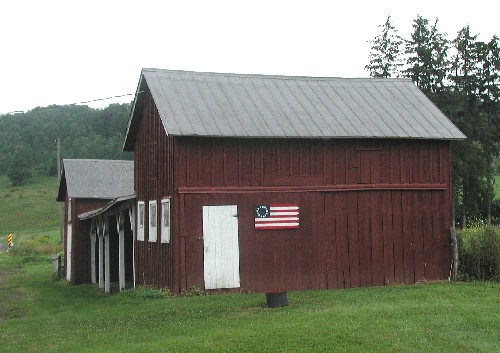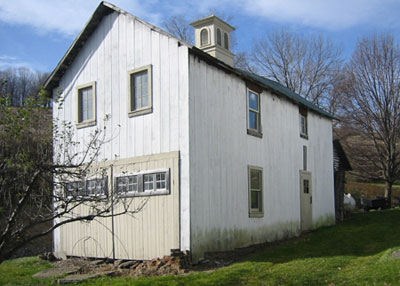Carriage House
A carriage house served to shelter horse drawn vehicles for carrying people, and also sometimes housed stalls and feed for horses. Large doors (either hinged or sliding) and few windows are characteristic features. A carriage house is difficult to distinguish from other shelters for animals and wagons. Some clues would be that a carriage house would not usually be as large as a barn, and it might sit on the same side of the road as the house and have a clear relationship to the dooryard; also, carriage houses not uncommonly had some ornamental architectural trim that would not always appear on a barn. Interiors would have large stalls and often a hayloft above. There is no known ethnic association of the carriage house. However, the very term "carriage house" suggests a dimension of prestige and status consciousness, and indeed carriage houses tend to be associated with wealthier estates.

Carriage house, Tioga County, c. 1900.
The building in the foreground has the characteristics of a carriage house:
large sliding doors on the eaves side (with a human door cut in), few windows,
small doors on the upper level suggesting a loft, and proximity to the road.

Carriage house, Delmar Township, Tioga County, c. 1890.
(Site 117-DE-003)
Note
This is a static, archived version of the PHMC Pennsylvania Agricultural History Project website which will not be updated. It is a snapshot of the website with minor modifications as it appeared on August 26, 2015.
Pages in this Section
- Overview
- House Types
- Barn Types
- Barn Features
- Outbuilding Types
- Overview
- Bake Oven
- Butcher House
- Carriage House
- Cider House
- Combination Structure
- Cook House
- Corn Crib
- Dryhouse
- Fruit Cold Storage
- Garage
- Grain Bin
- Granary
- Greenhouse
- Hay Drying Shed
- Hog House
- Horse Barn
- Ice House
- Machine Shed
- Maple Sugar House
- Milk House
- Packing House
- Potato Storage Cellar
- Poultry Housing
- Privy
- Roadside Stand
- Root Cellar
- Scale House
- Shed
- Silo
- Smokehouse
- Spray Shed
- Springhouse
- Summer Kitchen
- Wagon Shed
- Wash House
- Wood Shed
- Worker Housing
- Workshop
- Landscape Elements
- Archaeological Features